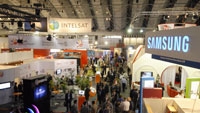Equipment vendors weathering the economic storm

It appears that for equipment vendors supplying technology to broadcasters in a tough economic climate, bigger is not always better.
At the IBC 2008 conference in Amsterdam last week, several large companies reported “flat” sales in the United States, while smaller ones said the past quarter was one of their best ever. Of course, a larger company has more pressure to achieve ever-higher sales numbers, so a flat quarter for Harris, Panasonic, Sony or Thomson could be the best sales results ever for an AJA Video, Broadcast Pix or Evertz Microsystems.
Based on numerous conversations, many of the smaller companies are weathering the storm by striking distribution deals with the larger companies, thereby giving them increased reach and access to clients and markets they might not be able to support on their own.
Recent examples include: Telecast Fiber Systems’ agreement with Thomson, whereby Thomson will sell its Infinity HD camcorder with Telecast’s Copperhead Fiber system; a variety of router suppliers (such as NVISION, Pro-Bel and Utah Scientific) working with Miranda to resell or bundle its Kaleido multiview software; and Snell & Wilcox’s sales partnership with Harris, which has resulted in Snell’s Kahuna switcher being included in large installations completed by Harris. These arrangements can be lucrative for both parties, although sales commission details have been are tricky to work out. If a Harris salesman sells a Kahuna switcher, what does that mean for the Snell sales rep?
“It makes senses for us to work with as many manufacturers as we can to give our products the best chance for success,” said Rick Cerny, president of Telecast Fiber Systems. His company just finished its best quarter in five years. “I think when times are tough, working together as an industry brings benefits for the customer and the vendor.”
Some of the more successful product categories include compression and transcoding solutions, 3Gb/s products, and file-based recording and distribution technology. Less popular, at least at the conference, are the more traditional products like cameras and video switchers.
As broadcasters endeavor to distribute content to multiple platforms, it helps to have an automated transcoding platform that converts video and audio clips into disparate streams that are meant to be consumed via a TV, the Internet and mobile devices. These platforms, from companies like Digital Rapids, Harmonic, Harris, MediaExcel, Streambox, TANDBERG Television and Thomson, were part of some of the more promising conversations at IBC. All of these companies’ technologies leverage the emerging H.264, AVC-I and QuickTime codecs to help broadcasters conserve their bandwidth, and all were used during the Summer Olympic Games in one form or another.
The professional video industry's #1 source for news, trends and product and tech information. Sign up below.
“In order to be successful in today’s bandwidth constrained world, a broadcaster has to have an automated transcoding platform in place if they expect to keep up with the competition popping up all around them,” said Tom Lattie, director of the Broadcast & Media Solutions division at Harmonic. “The lines of distribution are blurring. We live in a media world that’s no longer just about TV.”
While every router manufacturer showed 3Gb/s-compatible hardware frames and signal conversion modules, the tools for live production have been lacking. At this year’s show, however, FOR-A showed a new Hanabi 5000 series switcher that is capable of handling 3Gb/s signals in a single link configuration. Other companies, such as Sony (which claims to offer an end-to-end 3Gb/s production workflow), use two M/E channels (dual-link) to handle such HD productions. Single link 1080p switchers will surely be available from other switcher manufacturers, such as Snell & Wilcox and Thomson Grass Valley, at NAB 2009.
IT-based recording solutions were everywhere on the show floor, as broadcasters increasingly move toward tapeless environments. In Europe, every facility that is currently being upgraded or built from scratch includes a large component of file-based distribution. (Panasonic said 85 percent of broadcasters that have gone tapeless are dong so with its P2 solid-state gear.) System integrators are becoming well versed in such tapeless environments, which rely heavily of software.
OmniBus Systems continues to improve its iTX platform, which replaces much of yesterday’s automation, master control and playout hardware systems with software modules that can be scaled to grow as the need arises. This strategy, the company says, can reduce the capital costs of building a new facility by 50 percent. The company plans to release a 1080p/50 and 60 version of iTX by NAB 2009.
At IBC the company showed version 1.2, which includes the new iTX Edit module, a fast-paced editing application designed for news and sports applications. With iTX Edit, editors don’t have to wait for the program to render finished segments before they can be taken to air. The iTX playback engine renders the EDL in real time, with video and audio effects, stills and captions.
In another file-based content creation strategy, Quantel announced it has integrated Apple’s Final Cut Pro software into the Enterprise sQ server-based production environment. This gives editors the ability to access both full clips and metadata as well as to edited sequences generated on Quantel desktop and craft editing workstations. Final Cut Pro editors can now create stories, finish those started on workstations and publish directly to the server for playout.
So, while the stock market continues its roller coaster ride, broadcast equipment vendors are being creative and figuring out ways to stem the tide. Although many are enjoying profitable quarters, they all seem to recognize that tougher times are ahead.
“There’s a light at the end of the tunnel, but this time everyone thinks it’s a train,” said Jerry Gepner, vice president of business development at the Vitec Group.
The IBC2008 conference and equipment exhibition drew 49,250 attendees and manufacturer reps, its largest ever. This year it included more than 1400 exhibitors from all over the world.
